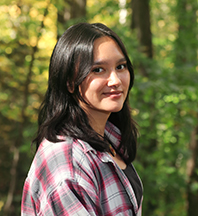Week of January 22, 2023 – January 28, 2023
by Sunny Guyette, Environmental Educator
The Harrison Trail is one of our newest additions (extending the Harrison Loop) and was one of the last trails that I had explored since starting at Baltimore Woods. Recently, I decided to take my first stroll along the whole Harrison Trail to find inspiration for writing a social media post and what I noticed was something very unique to not only the trail, but the Baltimore Woods Preserve!
I decided to enter the newly added trail closest to the Faust Wildflower Garden, where I could hear the distant shouts of excitement and play from the homeschool programs and the sound of water flowing from the stream down below. Down the hill from the entrance lies a big snapped American beech tree forming a bridge above the trail that sort of made me feel like I was in a National Park! It didn’t take long for something else to catch my eye, causing me to stop and fulfill my curiosity of trying to identify what type of mushroom was growing on a Yellow birch tree. After I took my picture of the mushroom, I noticed how big the Yellow Birch tree that it was feeding off really was. I thought to myself, “this is probably the biggest Yellow birch I have ever seen”. As I continued my hike, I started to hone in on all of the trees around me, how much larger in size they looked from any other community of trees at Baltimore Woods.
When I returned to the Interpretive Center, I learned that the Harrison trail runs right through a legacy forest or primary forest that we have at Baltimore Woods. Not to be confused with an old growth forest, a legacy forest is a forest that may have been logged in the 1800s but left alone from there after. The legacy forest at Baltimore Woods is located on a steep hill, which is most likely the reason as to why it was not included in agricultural practices. More evidence that leads us to believe that we have a legacy forest on the property can be seen in the spring when the understory is full of tell-tale plants and wildflowers, but other evidence that can be seen all year round are the sizable Yellow birches, Maples, American beech, and Hemlocks (which are very slow growing trees)!
Check out this part of the Harrison Loop on your next visit, it is truly a unique part of Baltimore Woods!


